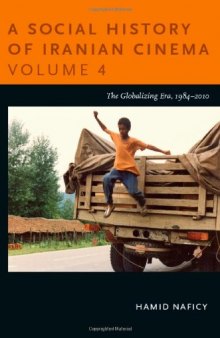 جزییات کتاب
جزییات کتاب
کتاب «تاریخ اجتماعی سینمای ایران» به زبان انگلیسی در 4 جلد به بررسی سینمای ایران از منظر تاریخ اجتماعی پرداخته و توسط حمید نفیسی تألیف شده است. دکتر حمید نفیسی استاد ارتباطات و سینما و تلویزیون در دانشگاه نورث وسترن ایالات و در دهه های گذشته از نخستین پیشگامان معرفی سینمای مستند، از جمله ژان روش، در ایران بود. او مشاور ارشد علمی «انسان شناسی و فرهنگ» در حوزه ارتباطات و سینما نیز هست و تا کنون به صورت مداوم با ما همکاری داشته است.
به مناسبت هشت سالگی انسانشناسی و فرهنگ «استاد محمد تهامینژاد» از پیشکسوتان سینمای مستند و پژوهشگران عرصهی سینما مقالهای بلند بر این کتاب ارزشمند نوشته و برای انتشار در اختیار این وبگاه قرار داده است.در زیر بخشی از مقدمهی این مقالهی بلند را میخوانیم:
اگر فقط یک جمله میتوانستم در باره کتاب تاریخ اجتماعی سینمای ایران بگویم این بود که" انسجام ساختاری شگفتآوری دارد". همچنین تمرکز بر تشخص فرهنگی زیر خیمه مدرنیته، برداشت کلی من از کتاب چهار جلدی تاریخ اجتماعی سینمای ایران نوشته دکتر حمید نفیسی است. در همه این شرایط، روح زمانه یعنی احساس و تلقی خاص فرهنگ ما ازتجدد وسنت در سینمای ایران، وجود داشته و الگوهای ذهنی و عملی متفاوت و گاه متعارضی را زیر آنچه که خیمه مدرنیته مینامم، آزموده است...
Hamid Naficy is one of the world's leading authorities on Iranian film, and A Social History of Iranian Cinema is his magnum opus. Covering the late nineteenth century to the early twenty-first and addressing documentaries, popular genres, and art films, it explains Iran's peculiar cinematic production modes, as well as the role of cinema and media in shaping modernity and a modern national identity in Iran. This comprehensive social history unfolds across four volumes, each of which can be appreciated on its own.The extraordinary efflorescence in Iranian film, TV, and the new media since the consolidation of the Islamic Revolution animates Volume 4. During this time, documentary films proliferated. Many filmmakers took as their subject the revolution and the bloody eight-year war with Iraq; others critiqued postrevolution society. The strong presence of women on screen and behind the camera led to a dynamic women's cinema. A dissident art-house cinema—involving some of the best Pahlavi-era new-wave directors and a younger generation of innovative postrevolution directors—placed Iranian cinema on the map of world cinemas, bringing prestige to Iranians at home and abroad. A struggle over cinema, media, culture, and, ultimately, the legitimacy of the Islamic Republic, emerged and intensified. The media became a contested site of public diplomacy as the Islamic Republic regime as well as foreign governments antagonistic to it sought to harness Iranian popular culture and media toward their own ends, within and outside of Iran. The broad international circulation of films made in Iran and its diaspora, the vast dispersion of media-savvy filmmakers abroad, and new filmmaking and communication technologies helped to globalize Iranian cinema.A Social History of Iranian CinemaVolume 1: The Artisanal Era, 1897–1941Volume 2: The Industrializing Years, 1941–1978Volume 3: The Islamicate Period, 1978–1984Volume 4: The Globalizing Era, 1984–2010
 درباره نویسنده
درباره نویسنده
حمید نفیسی (فارسی: حمید نفیسی؛ زادهٔ ۱ ژانویه ۱۹۴۴(1944-01-01)) از دانشوران سینماها و رسانههای جوامع دور از وطن، در تبعید، و پسااستعماری و سینمای ایران و سینمای آسیای غربی و media است.
 دانلود کتاب
دانلود کتاب
 جزییات کتاب
جزییات کتاب




 درباره نویسنده
درباره نویسنده





 این کتاب رو مطالعه کردید؟ نظر شما چیست؟
این کتاب رو مطالعه کردید؟ نظر شما چیست؟
